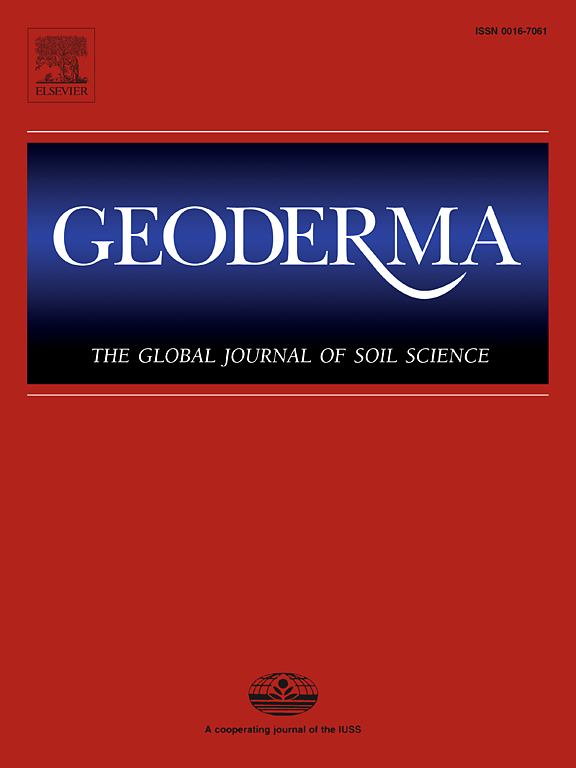Responses in different levels of biological organization in the soil invertebrate Enchytraeus crypticus exposed to field-contaminated soils from a mining area
IF 5.6
1区 农林科学
Q1 SOIL SCIENCE
引用次数: 0
Abstract
The sub-lethal ecotoxicity of field-contaminated soils toward small soil fauna, such as enchytraeids, remains understudied but holds paramount importance in soil pollution assessment. This study employed Enchytraeus crypticus to evaluate metal-contaminated soils from a mining area across various levels of biological organization, including individual level responses (survival, growth, reproduction, Cd/Pb/Zn accumulation), cellular level effects (peroxidase (POD), superoxide dismutase (SOD), glutathione (GSH), catalase (CAT), acetylcholinesterase (AChE), lipid peroxidation malondialdehyde (MDA)) and genetic alterations (olive tail moment (OTM) and tail DNA%). The study revealed considerable Cd and Pb accumulation, exerting adverse impacts on the reproduction and growth of the enchytraeids after a 21-day exposure. Changes in cellular and genetic parameters occurred with increasing exposure concentration and duration, indicating heightened lipid peroxidation and DNA damage in enchytraeids. A noteworthy metal detoxification process, evident at a physical level, was identified in E. crypticus, characterized by an initial escalation in toxicity followed by a subsequent decline. A distinctive complementary mechanism governing oxidative damage was detected in the enchytraeids, with an initial suppression of CAT activity, followed by inductions in SOD, POD, and GSH activity. Over the exposure duration, MDA content and DNA damage in the enchytraeids exhibited concentration-dependent shifts indicating their potential as efficient early-warning indicators for assessing the impact of Pb-Zn mining soils. This study contributes to a comprehensive understanding of the toxicological implications of metal-contaminated soils within the soil-enchytraeid framework.
土壤无脊椎动物隐翅虫(Enchytraeus crypticus)暴露于矿区受野外污染的土壤中不同生物组织水平的反应
田间污染土壤对小型土壤动物(例如隐翅虫)的亚致死生态毒性研究仍然不足,但在土壤污染评估中却具有极其重要的意义。本研究利用隐翅虫对矿区受金属污染的土壤进行了不同层次的生物组织评估,包括个体水平的反应(存活、生长、繁殖、镉/铅/锌积累)、细胞水平效应(过氧化物酶 (POD)、超氧化物歧化酶 (SOD)、谷胱甘肽 (GSH)、过氧化氢酶 (CAT)、乙酰胆碱酯酶 (AChE)、脂质过氧化丙二醛 (MDA))和遗传改变(橄榄尾矩 (OTM) 和尾 DNA%)。研究显示,镉和铅的累积量相当大,在接触 21 天后,会对漆虫的繁殖和生长产生不利影响。随着接触浓度和时间的增加,细胞和遗传参数也发生了变化,这表明脂质过氧化和 DNA 损伤加剧。在隐翅虫体内发现了一个值得注意的金属解毒过程,该过程在物理层面上非常明显,其特点是毒性在最初升级后随之下降。在隐翅虫体内发现了一种独特的氧化损伤互补机制,最初会抑制 CAT 活性,随后会增强 SOD、POD 和 GSH 活性。在暴露持续时间内,软体动物体内的 MDA 含量和 DNA 损伤呈现出浓度依赖性变化,这表明它们有可能成为评估铅锌矿土壤影响的有效预警指标。这项研究有助于在土壤-细胞器框架内全面了解金属污染土壤的毒理学影响。
本文章由计算机程序翻译,如有差异,请以英文原文为准。
求助全文
约1分钟内获得全文
求助全文
来源期刊

Geoderma
农林科学-土壤科学
CiteScore
11.80
自引率
6.60%
发文量
597
审稿时长
58 days
期刊介绍:
Geoderma - the global journal of soil science - welcomes authors, readers and soil research from all parts of the world, encourages worldwide soil studies, and embraces all aspects of soil science and its associated pedagogy. The journal particularly welcomes interdisciplinary work focusing on dynamic soil processes and functions across space and time.
 求助内容:
求助内容: 应助结果提醒方式:
应助结果提醒方式:


